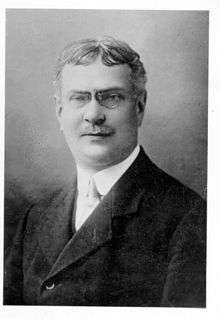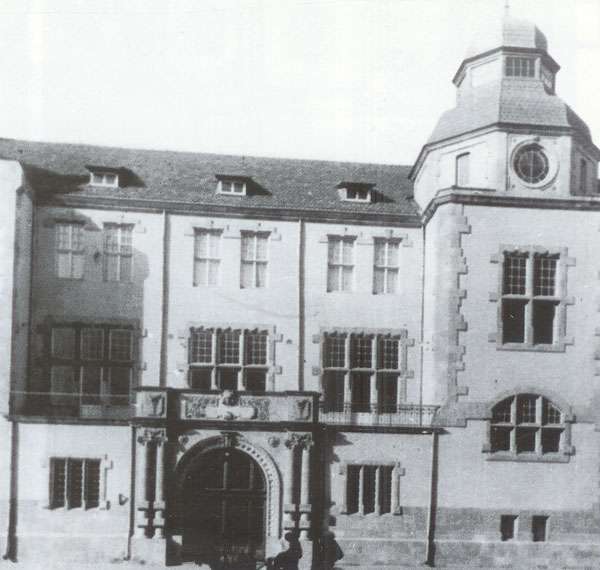Friedrich Schrader
| Friedrich Schrader | |
|---|---|
 Friedrich Schrader | |
| Born |
November 19, 1865 Wolmirstedt, Prussia |
| Died |
August 28, 1922 (aged 56) Berlin, Prussia, Germany |
| Nationality | Prussian, since 1916 German |
| Other names | Ischtiraki |
| Occupation | teacher, journalist, writer, newspaper editor |
Friedrich Schrader (November 19, 1865 – August 28, 1922) was a German philologist of oriental languages, orientalist, art historian, writer, social democrat, translator and journalist. He also used the pseudonym Ischtiraki (Arabic/Ottoman for "the socialist"). He lived from 1891 until 1918 in Constantinople (today Istanbul)
Life
Studies in Magdeburg and Halle (1865-1891)
Born in Wolmirstedt, Prussia, Friedrich Schrader passed his Abitur at the Domgymnasium Magdeburg. After studies of Oriental Languages and art history at the University of Halle he wrote his Ph. D. thesis on a translation of the "Karmapradipa" (an important Vedic sutra) into German. The work was done under the supervision of Professor Richard Pischel, at that time the most eminent scholar on vedic languages.
Teacher in Constantinople (1891-1907)
In 1891 Schrader took a position as a lecturer for German language and literature at Robert College in Bebek, close to Constantinople, where he lived with his family on the campus. Around 1900 he was "professeur" at a French-Armenian lycée in Pera, the European quarter of Constantinople (today Istanbul-Beyoğlu). Starting from the reign of Sultan Abdul Hamid II, Schrader began to translate contemporary Turkish literature and to write articles about it in German journals and newspapers such as Das Literarische Echo and Frankfurter Zeitung.
Beginnings as a journalist
From 1900, Schrader worked as a foreign correspondent for different German newspapers and journals. In the same period he published several articles in the official newspaper of the German SPD (Social Democratic Party), Vorwärts and in the theoretical journal of the party, Die Neue Zeit. In the articles, which he published under the pseudonym "Ischtiraki", he strongly criticized the official German policy in the Ottoman Empire, especially the focus on exploitation of economic and military-strategic interests while neglecting cultural exchange between the two nations and not engaging in the development of a modern civil society in the Ottoman Empire.
1907-1917 (Second Constitutional Era)

.
From 1907 until 1908 Schrader worked as a lecturer at the Russian Commercial College in Baku, and undertook field studies in the Caucasus region. One of his research topics were the Persian temples close to Baku located at natural gas sources, which are used for ritual flames.
In 1908-1917 Schrader, after the Ottoman revolution of 1908, returned to Constantinople and became, after some failed attempts to found a bilingual Turkish-German newspaper with Young Turkish friends (because the Turkish parts had to be printed with Arabic letters, the production costs became too high [1] ), co-founder and deputy Editor-in-chief for the bilingual (French-German) Constantinople-based daily newspaper Osmanischer Lloyd (French title Lloyd Ottoman). The paper was co-financed by the consortium running the Baghdad Railway project, the German Foreign Office, and the Berlin-based Bleichröder Bank. Schrader's feuilleton contributions about literature, arts, monuments and history of Constantinople were re-printed in many leading German daily newspapers (Frankfurter Zeitung, Kölnische Zeitung, Magdeburgische Zeitung), being collected in 1917 in the book Konstantinopel in Vergangenheit und Gegenwart.
Starting from 1908, Schrader lived with his British wife and his three sons in an apartment in the Dogan Apartmani in Beyoğlu.
In 1916 and 1917, when the policy of the Young Turks regarding ethnic minorities became increasingly evident, also tensions rose within the German community regarding the relation to the Turkish leadership. A Swiss colleague at the newspaper and younger mentee of Schrader, Max Rudolf Kaufmann, who shared Schrader's critical views on the German Turkish alliance, was arrested by the Turkish authorities after some of his letters home had been opened by Turkish intelligence, deported to Ankara, and later sent back to Germany, where he however was hired by Eugen Mittwoch for his Nachrichtenstelle für den Orient.
In 1917 Schrader himself was fired from his post as deputy editor at the Osmanischer Lloyd. To get rid of him, his opponents used an internal conflict with his editor-in-chief, Max Übelhör. Because of Schrader's eminent network in Istanbul and his profound knowledge, he was regarded however indispensable for the paper and continued to work as a freelancer for them until November, 1918.
Expert for the protection of monuments in Istanbul (1917-1918)
After 1917, Schrader could now focus on his historical and architectural interests. He published the book "Konstantinopel in Vergangenheit und Gegenwart" in 1917 in Tübingen, Germany. In parallel, he became a member of the Constantinople Municipal Commission for the Registration and Listing of Islamic and Byzantine monuments (which included the well-known Armenian photographer Hagop Iskender, at that time owner of the photography company Sabah and Joaillier. With a team of Turkish experts Schrader systematically catalogized monuments in the city threatened by the impact of war activities. Using archeological investigations, research, and interviews with locals, informations about the monuments were systematically gathered, while the monuments were photographed by Iskender. Valuable artefacts were recovered and preserved in the Archeological Museum of the city. The work remained unfinished since Schrader was forced to leave Constantinople after the German-Ottoman capitulation in November 1918.
In 1919, Schrader published a brief summary of the activities in a German journal,[2] the whereabouts of the recorded and collected material is unknown.
Journalist in Berlin (1919-1922)
In 1918-19 Schrader escaped from internment by the Allies by ship to Odessa. He left his ill British-Bulgarian wife and a male child in Constantinople. His two older sons, who were serving in the German-Turkish navy, were both demobilized to Germany. From Odessa he travelled in a railroad freight car through the war-ravaged Ukraine to Brest-Litovsk, where he reached the German front line. In his diary, published in Germany in 1919, he described several dangerous situations in connection with the various civil war factions, but also the very warm reception and strong support the refugees receive by the local Jewish population.
In Berlin, Schrader tried in vain to obtain employment in academia or diplomacy. From 1919 to 1920 he worked for the SPD-owned theoretical journal Die Neue Zeit, which had been the internationally most important Socialist and Marxist publication since the 1880s. In several articles Schrader voiced his criticism of the failed German Middle East policies before and during the First World War, especially in relation with the support for the Young Turkish regime and its attitude towards non-Muslim minorities. In an article published in 1920, Die Ägyptische Frage ("The Egyptian Question"), Schrader warned about possibly fateful and negative results of the Anglo-French colonial politics in the former Ottoman provinces Egypt, Palestine and Syria after World War I.
Schrader spent the last two years of his life in Berlin as freelance journalist, mainly writing for Deutsche Allgemeine Zeitung (DAZ), which was in the early years of the Weimar Republic still a liberal centre-right publication supporting the consolidation of Germany in the Weimar Republic (the foreign policy editor and later editor in chief at that time was Paul Lensch, a former SPD politician and associate of Parvus and Rosa Luxemburg).
Schrader died in August 1922 in Berlin, few weeks after DAZ had published his historic novel Im Banne von Byzanz.
Works
- Konstantinopel in Vergangenheit und Gegenwart (1917) ("Constantinople - Past and Present")
- translated into Turkish and re-published by Remzi Kitabevi in 2015: ISBN 978-975-14-1675-9 )
- Eine Flüchtlingsreise durch die Ukraine - Tagebuchblätter meiner Flucht aus Konstantinopel (1919) ("A refugee voyage through Ukraine - diary of my flight from Constantinople")
- Im Banne von Byzanz (1922, novel, published in "Deutsche Allgemeine Zeitung") ("Mesmerized by Byzantium")
Selected journal articles
- Neutürkisches Schrifttum: Das Literarische Echo, Band 3, 1900, S. 1686-1690
- Ischtiraki, 1900, Das geistige Leben in der Türkei und das jetzige Regime: Die Neue Zeit, Jahrgang 18, Band 2, pp. 548–555
- Ischtiraki, 1900, Vom Goldenen Horn: Vorwärts, Unterhaltungsbeilage, 31. Mai 1900 – 1. Juni 1900
- Die Kunstdenkmäler Konstantinopels: Der Neue Orient, 1919, Band 5, S. 302-304 und 352-354
- Politisches Leben in der Türkei: Die Neue Zeit, 1919, Jahrgang 37, Band 2, pp. 460–466
- Das Handwerk bei den Osmanli-Türken: Die Neue Zeit, 1919, Jahrgang 38, Band 1, pp. 163–168
- Die Lage der ackerbauenden Klasse in der Türkei: Die Neue Zeit, 1920, Jahrgang 38, Band 1, pp. 317–319
- Das Jungtürkische Lausanner Programm: Die Neue Zeit, 1920, Jahrgang 38, Band 2, pp. 6–11, 31-35
- Die ägyptische Frage: Die Neue Zeit, 1920, Jahrgang 38, Band 2, pp. 172 – 177
Sources
- Martin Hartmann, 1910, Unpolitische Briefe aus der Türkei: Leipzig, Verlag Rudolf Haupt
- Otto Flake, 1914, Aus Konstantinopel: Neue Rundschau, 15. Jg., Bd. 2, S. 1666 - 1687 (reprinted in: Das Logbuch, S. Fischer Verlag, Frankfurt, 1917
- Max Rudolf Kaufmann, Eine literarische Entdeckung - Schraders „Konstantinopel“: Mitteilungen der Deutsch-Türkischen Gesellschaft, Heft 17, 1957, S. 13-14 ISSN 0415-5289
- Çelik Gülersoy, Bibliographie: „Istanbul“ de Friedrich Schrader: Touring Et Automobile Club de Turquie: Janvier 1959, pp. 31–32
- N.N., Nachruf auf Dr. Friedrich Schrader, Deutsche Allgemeine Zeitung, 30. August 1922
- And, Metin, Mesrutiyet Döneminde - Türk Tiyatrosu 1908-1923: Türkiye Is Bankasi Kültür Yayinlari - 108, Ankara, 1971 (in Turkish language, mentions a memorial event staged by Schrader in 1909 in Istanbul on the occasion of the 150th death anniversary of Friedrich Schiller)
External links
- Karl Kautsky Papers at the IISG Amsterdam: Letter of Friedrich Schrader to Karl Kautsky, dated July 1900, D XX 441
References
- ↑ Irmgard Farah: Die deutsche Pressepolitik und Propagandatätigkeit im Osmanischen Reich von 1908–1918 unter besonderer Berücksichtigung des „Osmanischen Lloyd“. Beiruter Texte und Studien, Band 50, Hrsg. vom Orient-Institut der Deutschen Morgenländischen Gesellschaft, Beirut 1993, ISBN 3-515-05719-6
- ↑ F. Schrader, Die Kunstdenkmäler Konstantinopels: Der Neue Orient, 1919, Band 5, S. 302-304 und 352-354
|